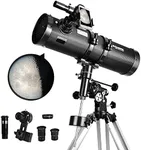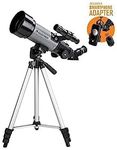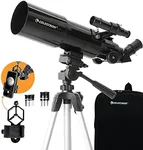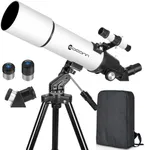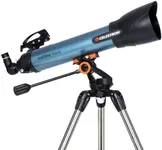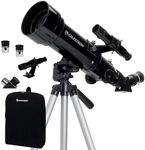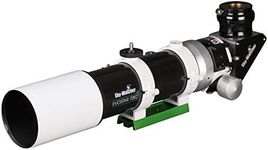Buying Guide for the Best Telescope For Beginners
Choosing a telescope for beginners can be an exciting journey into the world of astronomy. The right telescope can open up a whole new universe of stars, planets, and celestial wonders. When selecting a telescope, it's important to consider several key specifications that will affect your viewing experience. Understanding these specs will help you make an informed decision and find the best telescope for your needs.ApertureAperture refers to the diameter of the telescope's main lens or mirror. It is one of the most important specs because it determines how much light the telescope can gather. A larger aperture allows you to see fainter objects and more detail. For beginners, an aperture of 70mm to 100mm is a good starting point. If you are interested in viewing planets and bright deep-sky objects, a larger aperture will be beneficial.
Focal LengthFocal length is the distance between the telescope's lens or mirror and the point where it forms an image. It affects the magnification and field of view. A longer focal length provides higher magnification, which is great for viewing planets and the moon. A shorter focal length offers a wider field of view, making it easier to locate and observe larger objects like star clusters. Beginners might prefer a telescope with a moderate focal length for versatility.
Mount TypeThe mount is the part of the telescope that supports and allows it to move. There are two main types: altazimuth and equatorial. Altazimuth mounts are simpler and easier to use, making them ideal for beginners. They move up-down and left-right, similar to a camera tripod. Equatorial mounts are more complex and designed for tracking celestial objects as they move across the sky. If you're just starting out, an altazimuth mount is usually the best choice.
EyepiecesEyepieces are interchangeable lenses that determine the magnification of the telescope. Most telescopes come with one or two eyepieces, but you can purchase additional ones for different viewing experiences. Eyepieces are measured in millimeters; lower numbers provide higher magnification. For beginners, having a range of eyepieces (e.g., 10mm and 25mm) will allow you to explore different magnifications and find what works best for your interests.
PortabilityPortability refers to how easy it is to transport and set up the telescope. If you plan to take your telescope to different locations or need to store it when not in use, consider its size and weight. Smaller, lightweight telescopes are easier to handle and set up, making them ideal for beginners who may not have a dedicated space for stargazing. Look for telescopes that are easy to assemble and disassemble.
Optical QualityOptical quality refers to the clarity and sharpness of the images produced by the telescope. High-quality optics will provide better views and more enjoyable stargazing experiences. Look for telescopes with good reviews on their optical performance. For beginners, it's important to find a balance between quality and ease of use. Avoid telescopes with plastic lenses and opt for those with glass optics for better image quality.



